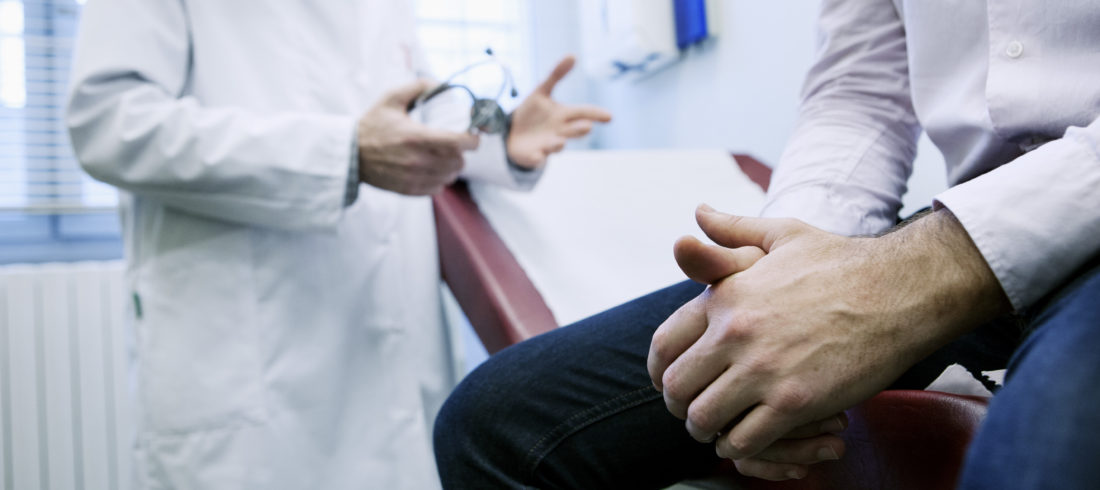It’s often said that pain is the body’s early warning system. In the case of the male reproductive system, attending to pain may preserve fertility.
You don’t have to be a martial arts expert to know that a blow to the scrotum tends to incapacitate a man, no matter how tough he might be. The testicles are actually organs suspended outside the body in the somewhat protective pouch of the scrotum. When they are subjected to blunt force trauma, most commonly from a sports injury or a blow, the resulting pain is deeper and more intense.
The initial rush of pain occurs as the testicle swells. Then, the pressure caused by the swelling impinges on the surrounding nerves, spreading the pain to the lower abdomen, which is why such an injury is often accompanied by nausea.
“In most cases, depending on the severity of the blow, the pain starts relaxing considerably within an hour or less,” says Dr. Walter Parker of Premier Medical Group’s Urology Division. “If there is a great deal of persistent pain, bruising and swelling, that suggests a higher grade injury. A severe trauma can fracture the tunica vaginalis, the membrane covering the testicle, and that needs to be medically attended to,” he says.
The most severe form scrotal pain is a result of testicular torsion. Each testicle is suspended in the scrotum by a spermatic cord that contains blood vessels, nerves and the ducts carrying sperm from the testicle. If the testicle twists about on the cord (torsion), blood supply to the testicle can be cut off and, without prompt medical care, lead to losing the testicle.
“Testicular torsion is most common in teenagers, but it can come at any age,” says Dr. Parker. “I’ve seen it in infants and in 70-year-old men.” The condition is relatively rare, affecting about 1 in 4,000 males under the age of 25 annually. Torsion can follow strenuous activity, such as heavy lifting, or trauma, but it often occurs for no apparent reason and the pain of it may begin abruptly during sleep. The abrupt and excruciating pain of testicular torsion should be considered an urgent message to seek emergency care.
Progressively painful, the onset of acute epididymitis—which often develops over a 24-hour period—serves as a warning of infection of the epidiymis, a coiled tube that collects sperm from the testicle. “In younger patients, say under 35, epididymitis tends to be the result of an STD, such as gonorrhea or chlamydia,” says Dr. Parker. “In older patients, it is more likely to be connected to urinary tract infection, which is sometimes related to BPH or bacterial prostatitis.” The pain of epididymitis typically starts at the back of one testicle and then spreads to involve the whole scrotum, accompanied by swelling, tenderness, redness, and warm skin.
The condition is successfully managed with antibiotics, either broad-spectrum or targeted to the particular bacterium involved.
The sudden pain of orchitis, an inflammation of one or both testicles, ranges from mild to severe. The condition is usually associated with the virus that causes mumps and more than one-third of post-puberty males who contract mumps will develop it. Orchitis may also have a bacterial origin, or spread from existing epididymitis, in which case it’s called epididymo-orchitis.
Bacterial orchitis is treated with antibiotics plus rest, ice packs and analgesics for pain control. Treatment for viral orchitis is palliative while the body’s immune system fights off the virus over the course of 3-10 days.
Just because scrotal pain isn’t severe doesn’t mean it’s not serious. The pain of testicular cancer can be a dull ache or sense of heaviness in the scrotum. Often, this pain will be felt in the groin, abdomen, or lower back. If there is swelling, a lump, or a change in the size or shape of a testicle, it’s important to get checked out for testicular cancer.
More than just the cancerous growth itself, treatment for testicular cancer can also cause discomfort and impaired function, especially in cases where chemotherapy and radiation are necessary. The sooner you get checked out for scrotal pain and diagnosed with cancer, the less likely that the more aggressive forms of treatment will need to be used. In any case, it’s a good idea to know what to expect and what questions to ask when you have testicular cancer.

